10 Steps to Building a Strong Customer Success Team
Customer success teams are responsible for connecting with customers and ensuring they have the information needed to effectively use a business’s offerings.
Managing the whole customer success area is quite tough. To make your customers successful you need a strong customer success team who will work dedicatedly. They will follow a data-driven and proactive approach to help customers with the products or services more effectively.
A well-designed customer success program can yield a 91% ROI over three years. From customer engagement to service renewal, the client success team should handle all these areas like a pro.
Whether you are a small startup or a large corporation, having a dedicated customer success team can make a significant difference in retaining customers, driving revenue and building a positive brand reputation.
Let us explore the importance of a consumer success team, the key functions they perform and how they can contribute to the overall success of a business.
A customer success team is defined as a group of professionals within a company who are dedicated to ensuring that customers are successful in using the products or services in the right way. The team plays a crucial role in building strong client relationships, increasing customer loyalty and driving business ROl.
The key objectives of a customer success team include:
As per Gartner marketing survey, almost two-thirds of all organizations say that the major driver for the competition is mostly the customer experience. Hence, a client success team is a key component of any business, responsible for ensuring that customers are satisfied or not. The team focuses on strengthening customer relationships, helping them get the most value out of their purchases.
So, what exactly is a customer success team responsible for?
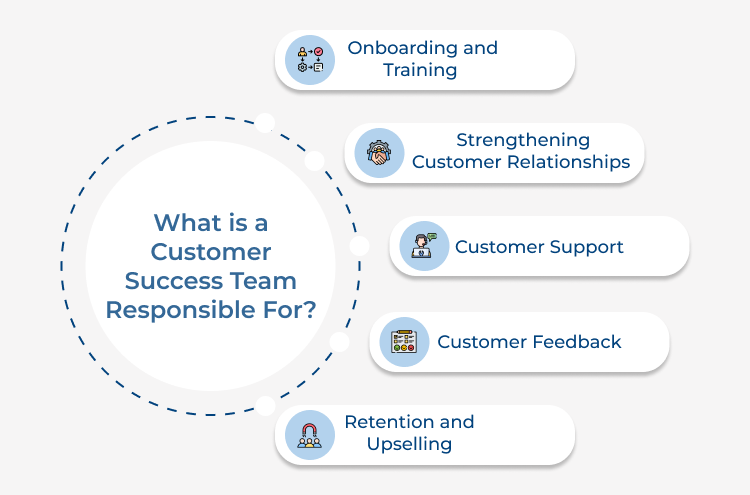
Let us discuss some key responsibilities of a client success team:
The customer success team makes the customer onboarding process smooth and ensures they have a successful start with the products/services. The process includes providing training and guidance on how to use the product effectively.
Building strong customer relationships is a top priority for the customer success team. It involves regular communication, understanding the customer’s needs and providing personalized support and guidance.
Customer success teams act as the primary point of contact for customers who have questions, issues, or concerns. They are responsible for understanding customer requirements and resolving them effectively on time.
Gathering and analyzing customer feedback is another key responsibility of the client success team. By understanding customer needs and pain points, the team can make informed decisions on how to improve the product or service.
Consumer success teams play a crucial role in driving customer retention and upselling opportunities. By ensuring customers are satisfied, the team can help retain customers and potentially upsell additional products or services.
Building a successful customer success team is essential for any business looking to achieve long-term growth and success. A customer success team is responsible for ensuring that customers are satisfied with the products or services they have purchased and that they continue to find value in what the business has to offer.
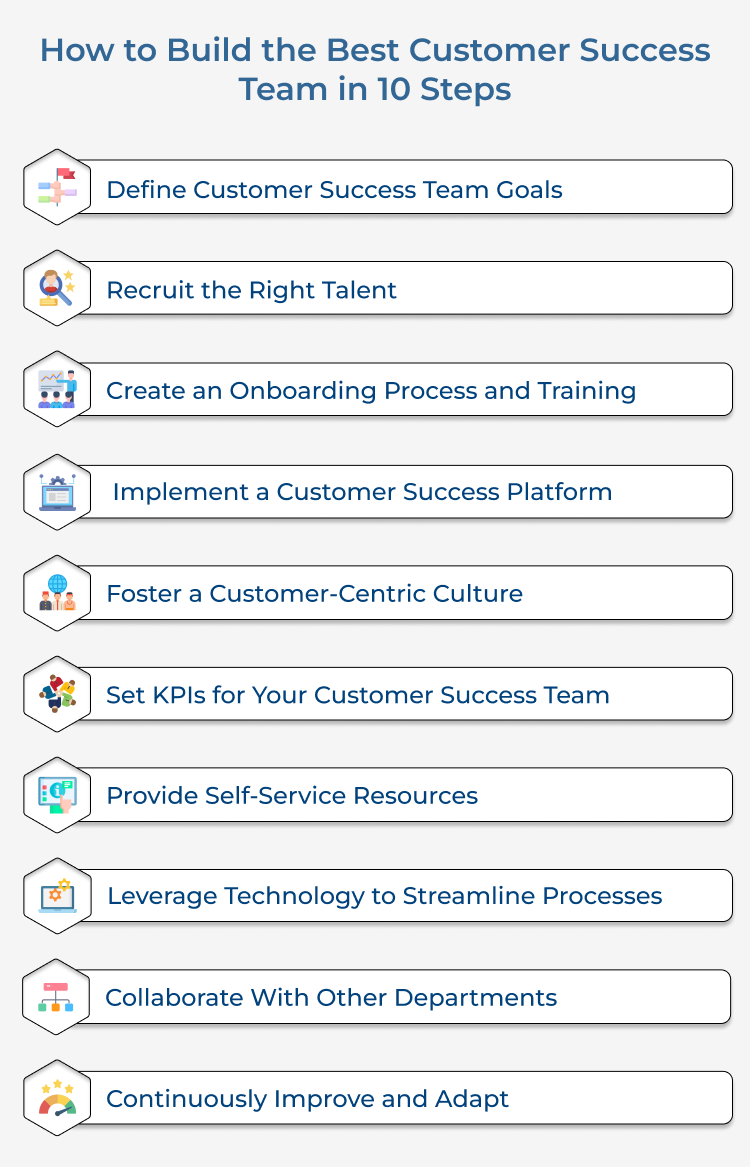
Let us discuss the 10 steps that will help you to build a powerful customer success team for your business.
Before you begin building your customer success team, it is important to clearly define the goals and objectives that you want the team to achieve.
These goals should align with the overall business objectives and be focused on improving the customer satisfaction index. By having a clear direction for the team, you can ensure that everyone is working towards the same objectives.
Best practices
When building a customer success team, it is important to hire individuals with the right skill set and experience needed to succeed in their roles.
Consider candidates with strong communication skills and a comprehensive understanding of customer service best practices. Choose individuals with diverse backgrounds to bring fresh perspectives to the team.
Best practices
Onboarding the recruited customer success team members is the next step in building a successful customer success team. It is crucial to provide them with the necessary training and resources to succeed in their roles.
Develop an onboarding process that introduces new team members to the company culture, values and processes. Provide ongoing training and development opportunities to ensure that team members have the skills they need to effectively support customers.
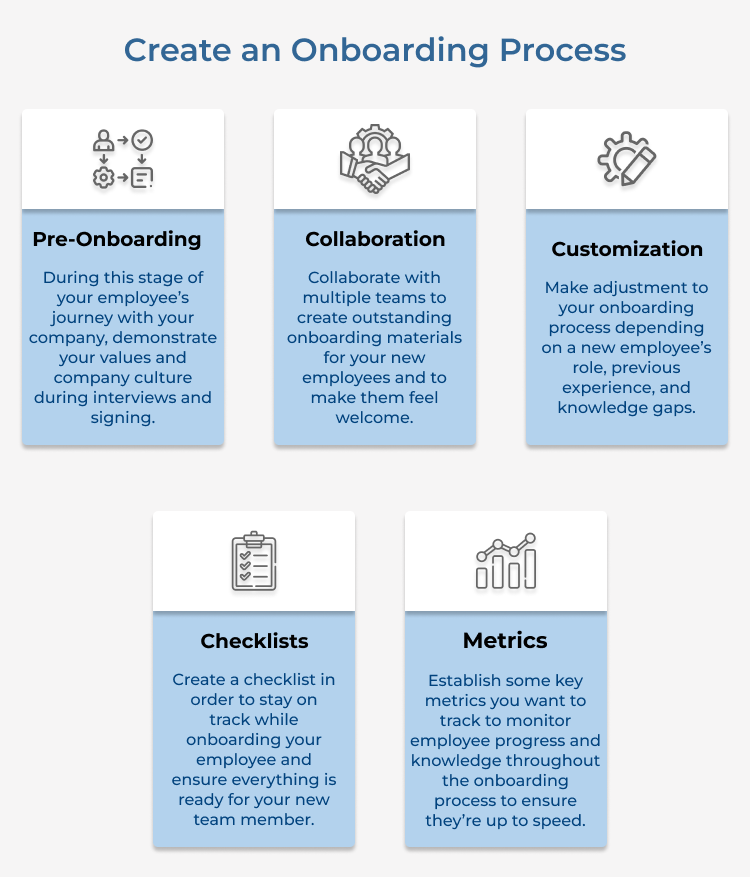
Best practices
Invest in a customer success platform that will enable your team to track customer interactions, monitor customer satisfaction and identify areas for improvement.
A customer success platform can help streamline processes, increase efficiency and provide valuable insights into customer behavior and preferences. Invest in a platform that aligns with your business goals and provides the features that your team needs to succeed.
Best practices
Building an efficient customer success team requires a customer-centric culture within the organization.
Encourage team members to prioritize customer needs and empower them to go the extra mile to deliver exceptional customer service. By creating a culture that values customer success, you can ensure that every interaction with customers is positive and rewarding.
Best practices
Measuring the success of your customer success team is very important. You can set specific goals and key performance indicators (KPIs) that align with your business objectives.
These KPIs should be measurable, achievable and relevant to the team’s responsibilities. By tracking performance against the specific goals, you can identify areas for improvement and make informed decisions to drive success.
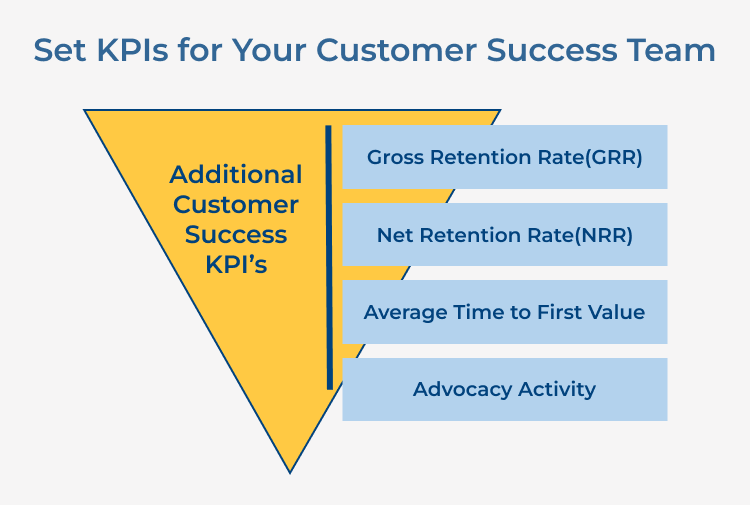
Best practices
Empower customers to find answers to their questions on their own by providing self-service resources such as knowledge bases, FAQs and video tutorials.
You can reduce the burden on your customer success team and enable customers to find the information they need quickly by offering self-service options. The self-service resources can help build customer loyalty by providing effective support on time.
Best practices
Leverage technology to streamline processes and improve efficiency within your customer success team.
Invest in customer relationship management (CRM) software, ticketing systems and other tools. These can help automate tasks, track customer interactions and provide valuable insights into client behavior.
Implementing advanced technology, can help to improve productivity, reduce response times and deliver a seamless customer experience.
Best practices
Collaboration is the key towards effectively supporting customers. It is important for the customer success team to collaborate with other departments within the organization, such as sales, marketing and product development.
Working closely with other teams helps the client success team gain valuable insights into their preferences, identify opportunities for improvement and align strategies to deliver a seamless customer experience.
Encourage cross-functional collaboration and communication to ensure that everyone is working towards the same goals.
Best practices
Building the best customer success team requires a commitment to continuous improvement and adaptation.
You have to monitor customer feedback, track key metrics and solicit input from team members to identify areas for improvement. Based on it you can make adjustments as needed. By staying responsive to changing customer needs and market conditions, you can ensure that your customer success team remains successful in the long term.
Best practices
A high-performing customer success team is essential for any business looking to retain customers, drive growth and build a strong reputation in the marketplace. To achieve success in this area, there are several key pillars that need to be in place.
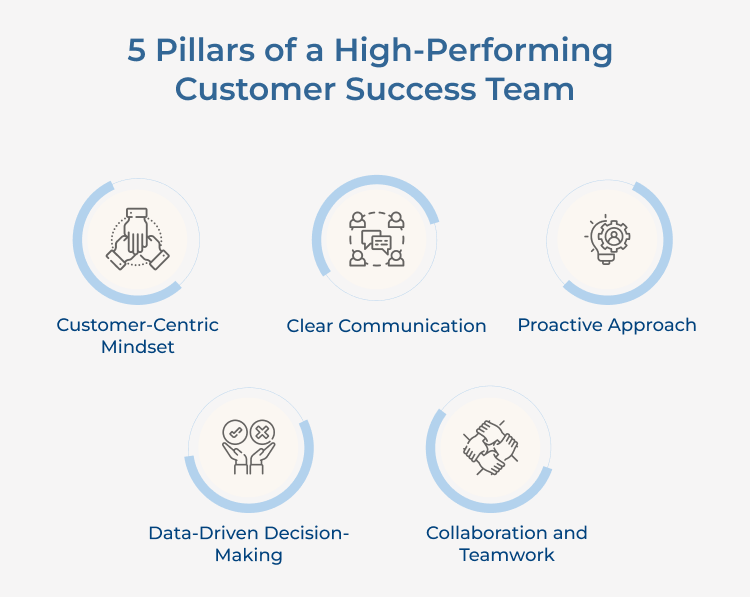
Here are some of the key components of a high-performing customer success team:
The customer success team needs to have a deep understanding of the customer’s needs and to be committed to helping them achieve success. The mindset should drive all interactions and decisions made by the team.
Effective communication is crucial for a customer success team. Team members should be able to communicate clearly with customers and stakeholders. It includes actively listening to the customers, providing timely updates and addressing their concerns promptly.
A high-performing customer success team takes a proactive approach to customer management. It means anticipating customer needs and providing value-added services to improve customer experience. By being proactive, the team can avoid problems before they arise and build lasting client relationships.
Data is a powerful tool for customer success teams. By analyzing customer data, team members can identify areas for improvement, track customer satisfaction and make informed decisions. Using data helps the team focus on the most impactful strategies and tactics.
A high-performing customer success team works collaboratively with other departments within the organization. Team members should be able to work effectively with sales, marketing, product development and other teams to ensure a seamless customer experience.
Customer success teams are an essential part of any company that values customer satisfaction and retention. These teams are responsible for ensuring that customers have a positive experience with the company’s products or services and ultimately become loyal customers.
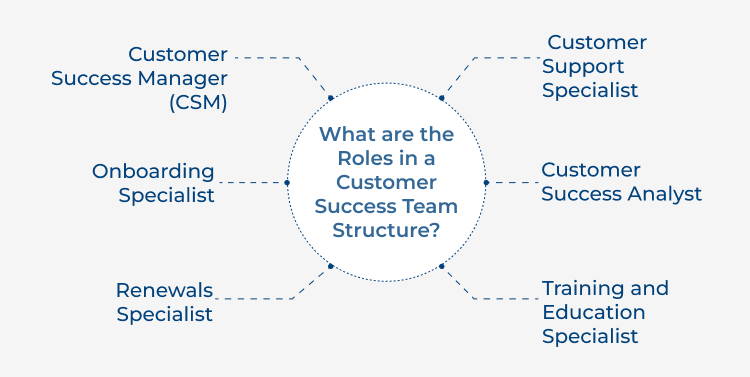
Here are the key roles typically found in a customer success team structure:
1. Customer Success Manager (CSM): The CSM is responsible for building strong relationships with customers and ensuring that their needs are met. They act as the main point of contact for the customer and advocate on their behalf within the company.
2. Customer Support Specialist: The role is focused on providing technical support to customers when they have queries about the product or service. Customer support specialists are approached by the customers seeking help.
3. Onboarding Specialist: The onboarding specialist is responsible for guiding new customers through the process of getting started with the products/services. They ensure that customers understand how to use the product and are set up for success from the beginning.
4. Customer Success Analyst: The role focuses on analyzing customer data and metrics to identify areas where customer success initiatives can be optimized. Customer success analysts help track customer satisfaction and retention metrics to ensure the team is meeting its goals.
5. Renewals Specialist: The renewals specialist is responsible for managing the renewal process for existing customers, ensuring that they continue to use and pay for the product or service. They work closely with the sales & client success teams to secure renewals and prevent customer churn.
6. Training and Education Specialist: The role focuses on creating training materials, resources and programs to help customers improve their knowledge of the product or service. Training and education specialists play a crucial role in ensuring that customers can maximize the value they get from the product.
While both teams may overlap in some aspects, there are key differences between the two that are important to understand.
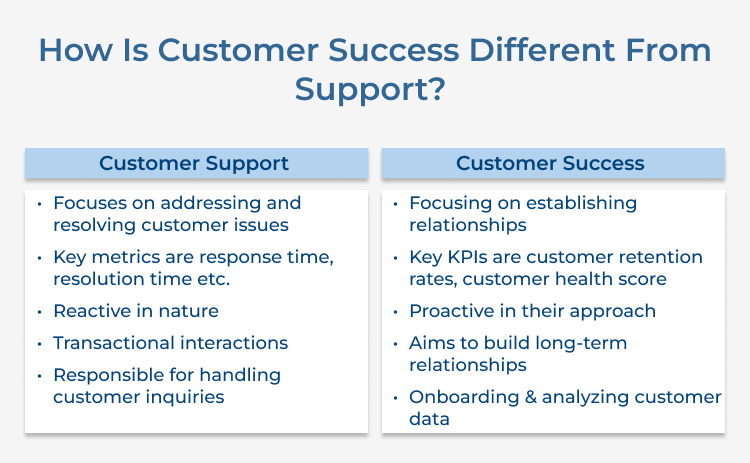
Here are key differences between Customer Success and Customer Support teams:
Customer Support teams are primarily focused on addressing and resolving customer issues in a reactive manner. They respond to customer complaints, provide technical assistance and troubleshoot problems as they arise.
Customer Success teams take a proactive approach by focusing on establishing and nurturing long-term relationships with customers. They work to understand the needs and help them achieve success with the company’s products or services.
The goals of the customer support team is resolving customer issues efficiently, minimizing customer churn and maintaining customer satisfaction. Customer Support is often measured by metrics such as response time, resolution time and customer satisfaction scores.
Customer Success teams are focused on ensuring that customers achieve their desired outcomes and derive value from the product or service. They are measured by metrics such as customer retention rates, customer health scores and expansion revenue.
Customer Support teams are reactive in nature, meaning they respond to customer inquiries and issues as they arise. They may reach out to customers to offer assistance or follow up on a ticket, but their primary focus is on resolving existing problems.
Customer Success teams are proactive in their approach. They anticipate customer needs, provide proactive guidance and work to prevent issues before they arise.
Customer Support teams have transactional interactions with customers, where the main goal is to address specific issues. These interactions are often short-term and focused on resolving immediate problems.
The customer success teams aim to build long-term client relationships based on trust, loyalty and mutual success. They work closely with customers to understand their goals, and help them achieve success over the long term.
Customer Support teams are typically responsible for handling customer inquiries, troubleshooting technical issues, providing product training and escalating complex problems to higher levels of support. Their main focus is on resolving issues related to the product or service.
Customer success teams have a broader scope of work that includes onboarding new customers, conducting regular check-ins, analyzing customer data and driving customer engagement.
Establishing a customer success team is crucial for any business looking to improve customer satisfaction and retention. A strong customer success team can help ensure that customers are getting the most out of their products or services and ultimately lead to increased revenue.
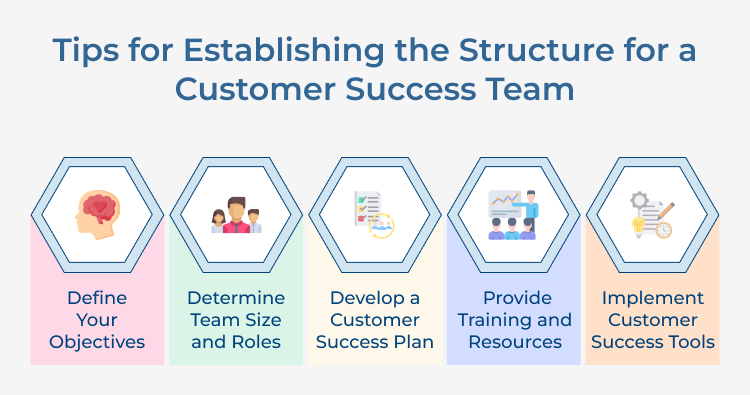
Here are some tips for establishing the structure for a successful customer success team:
Before you start building your customer success team, it’s important to clearly define your objectives. What are the goals and responsibilities of the team? Are you focusing on reducing churn, increasing customer loyalty or improving customer satisfaction?
Having a clear understanding of what you want to achieve will help you determine the structure and size of your team.
Once you have a clear idea of your objectives, you can start determining the size and roles of your customer success team. Consider the size of your customer base, the complexity of your products or services and the level of support your customers need.
Common roles within a customer success team include customer success managers, account managers, onboarding specialists and support representatives.
Create a customer success plan that outlines the steps your team will take to achieve your objectives. The plan should include strategies for onboarding new customers, managing customer relationships and preventing churn.
It should also outline key metrics that will be used to measure the success of the team, such as customer satisfaction scores, retention rates and upsell opportunities.
It’s important to provide your customer success team with the training and resources they need to be successful. It could include training on your products or services, customer service best practices and tools for managing customer relationships.
You can ensure that they have the skills and knowledge they need to effectively support your customers by investing in the development of your team.
There are many customer success tools available that can help your team streamline their processes and provide better support to customers.
Customer relationship management (CRM) software, customer feedback tools and communication platforms can all help improve the efficiency and effectiveness of your customer success team. Be sure to choose tools that align with your objectives and the needs of your team.
As your business grows, it is important to scale your customer success efforts to ensure that you are able to effectively support and retain your growing customer base.
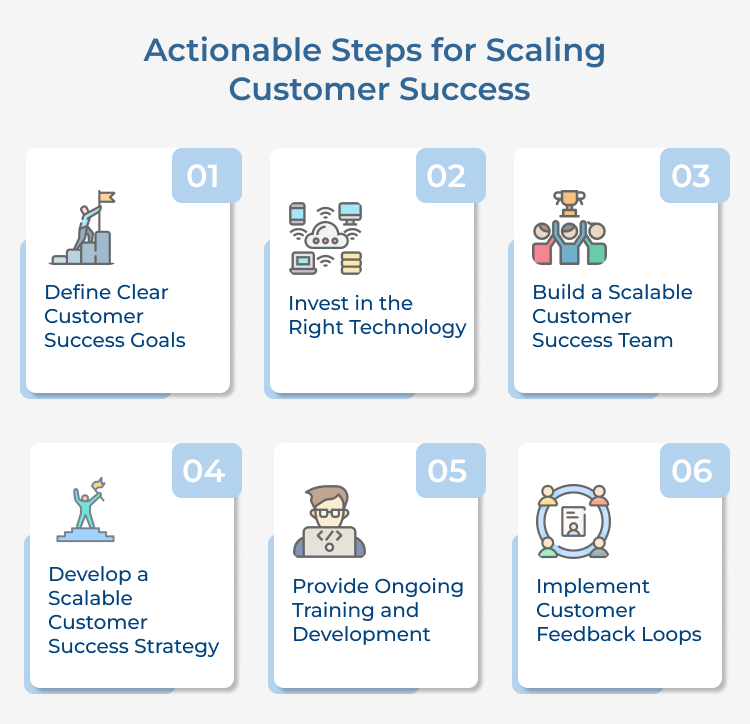
Here are some steps for scaling customer success:
1. Define clear customer success goals: Before you can effectively scale your customer success efforts, you need to clearly define what success looks like for your customers and establish key metrics to measure it. It will help you track the effectiveness of your customer success initiatives and make data-driven decisions for scaling.
2. Invest in the right technology: To scale your customer success efforts, you need to invest in the right tools and technology that can help you automate processes, track customer interactions and analyze customer data. Customer relationship management (CRM) software, customer feedback tools and customer success platforms can all help streamline your customer success operations.
3. Build a scalable customer success team: As your customer base grows, you may need to expand your customer success team to ensure that you can effectively support your customers. Hire customer success managers, customer support agents and customer success specialists who can help manage customer relationships, address customer inquiries and drive customer satisfaction.
4. Develop a scalable customer success strategy: Create a customer success strategy that can be easily replicated and scaled as your business grows. It may include standardizing customer communication processes, implementing customer onboarding and training programs and establishing customer success playbooks that outline best practices for managing customer relationships.
5. Provide ongoing training and development: To ensure that your customer success team is equipped to support your growing customer base, provide ongoing training and professional development opportunities. Invest in customer success training programs, workshops and certifications to help your team stay up-to-date on industry trends.
6. Implement customer feedback loops: To continuously improve your customer success efforts, implement feedback loops that allow you to gather insights from your customers on their experiences with your products/services. Use this feedback to identify areas for improvement, address customer pain points and enhance the overall customer experience.
Having an empowered customer success team can truly take your business to new heights. By investing in training, providing resources and fostering a culture of empowerment, your team will be better equipped to handle customer inquiries. They can resolve issues efficiently and drive customer satisfaction.
When your consumer support team feels empowered, they are more likely to go the extra mile to ensure a positive client experience. It will not only improve your bottom line but also strengthen your brand reputation. So, invest in your team, empower them to succeed and watch your business thrive like never before.
1. What is the structure of the customer success team?
The structure of a customer success team can vary depending on the size and type of the business. Typically, a customer success team includes roles such as Customer Success Managers, Account Managers, Technical Support Specialists and Customer Advocates. These team members work together to ensure customer satisfaction and retention.
2. How are customer support and customer success teams different?
Customer support teams are usually focused on resolving specific issues or problems that customers may have with a product or service. Customer success teams, on the other hand, take a more proactive approach by building relationships with customers, understanding their needs and helping them achieve success with the product or service.
3. When to start building a customer success team?
It is recommended to start building a customer success team as soon as possible, especially if your business relies on recurring revenue from customers. By investing in a customer success team early on, you can improve customer retention rates, increase customer lifetime value and differentiate your business from competitors.
4. Who makes up a customer success team?
A customer success team can include a variety of roles, such as Customer Success Managers, Account Managers, Technical Support Specialists and customer advocates. These team members work together to ensure that customers receive the support and resources they need to be successful with the product or service.
5. What technology does a customer success team need?
Customer success teams often rely on Customer Relationship Management (CRM) software, customer support tools, data analytics platforms and communication tools. They effectively manage customer relationships and track customer interactions. These technologies can help customer success teams streamline processes, automate tasks and provide personalized support to customers.